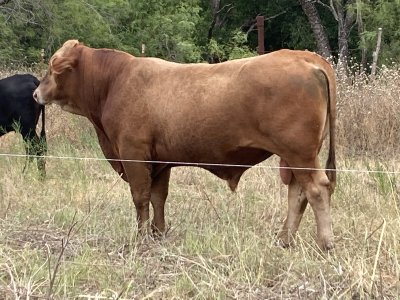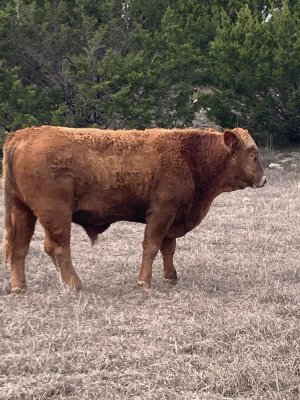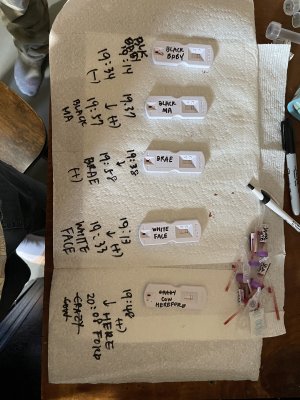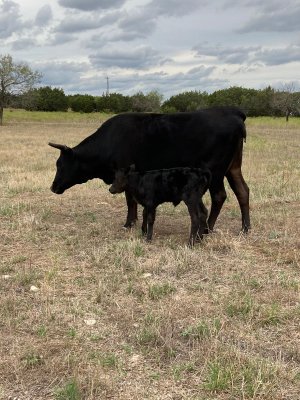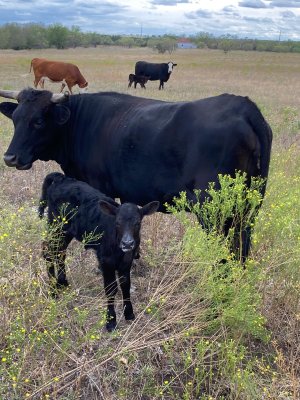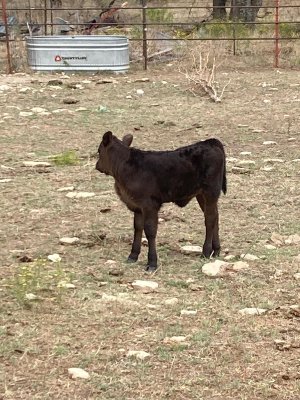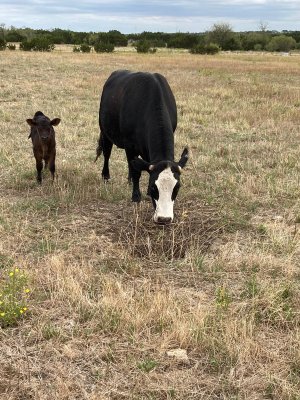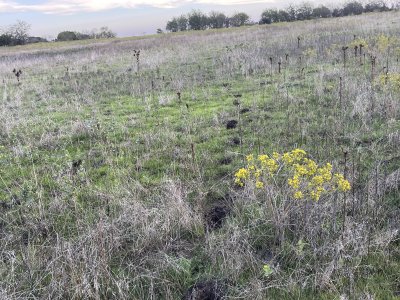The seller sold the bull with out a fert test also so...I just don't get why anyone would not worm as part of their program to start with. I mean... you can go down the road and tell which people are "saving money" by not worming easily enough.
Worming is like pennies on the dollar compared to feed.
You are using an out of date browser. It may not display this or other websites correctly.
You should upgrade or use an alternative browser.
You should upgrade or use an alternative browser.
Best Cattle Crosses For Unassisted Calving
- Thread starter rocfarm
- Start date

Help Support CattleToday:
rocfarm
Well-known member
Again, will do if things look off. Just not worried about it at this point. The bull has some decent flesh and weighs within the average range of what he should, I think. And he just came off of running with a large herd and drought affected grass. But, with all of the other things I've had to adjust so far, I wouldn't be surprised if I have to get it done.You have to do you. But deworming can add BCS quicker and cheaper than feeding extra.
IF in doubt, take a stool sample to the vet. Very easy. No guessing.
rocfarm
Well-known member
@Jeanne gets itI just don't get why anyone would not worm as part of their program to start with. I mean... you can go down the road and tell which people are "saving money" by not worming easily enough.
Worming is like pennies on the dollar compared to feed.
rocfarm
Well-known member
Actually he offered me another bull that had just had one. He's a really competent cattleman and his family has been a big part of the county for decades, so I definitely wouldn't blame him. It's all on me and my newbie moves.The seller sold the bull with out a fert test also so...
I know the risks I'm taking. I take full responsibility.
rocfarm
Well-known member
And thanks for all the comments, All. Kind of like an extra Christmas present. I'll post updates on the bull here as well.
rocfarm
Well-known member
Dear Cattle Today Crowd,
About a year-and-a-half ago I asked for some advice on this site about how to run a herd that minimized problems with unassisted calving.
I promised I'd update everyone on how it turned out, so here's the current update.
Couldn't really be selective in the end, because of limited types of cattle at auction and financial constraints. Ended up buying a motley herd and put a red angus bull on them. Wasn't able to test the bull at purchase, but he looked sound all around and was a virgin bull, so I took a risk. Here's the pics. The one where he has the winter coat is from Dec. The other pic was from August.
About a year-and-a-half ago I asked for some advice on this site about how to run a herd that minimized problems with unassisted calving.
I promised I'd update everyone on how it turned out, so here's the current update.
Couldn't really be selective in the end, because of limited types of cattle at auction and financial constraints. Ended up buying a motley herd and put a red angus bull on them. Wasn't able to test the bull at purchase, but he looked sound all around and was a virgin bull, so I took a risk. Here's the pics. The one where he has the winter coat is from Dec. The other pic was from August.
Attachments
rocfarm
Well-known member
He had a total of 6 cows he could breed. Because my operation is so small, I didn't deem it feasible to have my cows preg tested by a vet. I found some on farm pregnancy tests (IDEXX). Ran the cattle up into a chute and preg tested four of the 6 cows myself. Also preg tested a heifer to make sure she wasn't bred, as it was a bit too early.
Every cow we tested was with calf, so I got lucky on the bull.
The tests turned out to be highly accurate. So, they get a thumbs up from a novice cattleman. Here's a pic of the tests.
Every cow we tested was with calf, so I got lucky on the bull.
The tests turned out to be highly accurate. So, they get a thumbs up from a novice cattleman. Here's a pic of the tests.
Attachments
rocfarm
Well-known member
As of October 11th, we have two calves on the ground. One from a first-calf Corriente cow and another from a 4 or 5-year-old cross cow.
Again, a few pics.
Again, a few pics.
Attachments
Travlr
Well-known member
He looks more like a Beefmaster with that extra skin in the smooth coated pic.Dear Cattle Today Crowd,
About a year-and-a-half ago I asked for some advice on this site about how to run a herd that minimized problems with unassisted calving.
I promised I'd update everyone on how it turned out, so here's the current update.
Couldn't really be selective in the end, because of limited types of cattle at auction and financial constraints. Ended up buying a motley herd and put a red angus bull on them. Wasn't able to test the bull at purchase, but he looked sound all around and was a virgin bull, so I took a risk. Here's the pics. The one where he has the winter coat is from Dec. The other pic was from August.
rocfarm
Well-known member
We still have four more cows to go, but so far the cows have had an easy time calving and are thriving. As I promised, I'll post an update on how the rest of the herd does when calving season is over.
All in all, it seems that, even if you are on a budget, it is quite possible to run a herd on the cheap that is not too much maintenance.
It seems like the first calf crop will cover most of the cost of buying the herd. A few takeaways from a novice to other potential novices out there:
1) Maybe don't get hung up on getting 'great' cows and a 'great' bull if you are starting out. Rather, maybe do a bit of research and try to pick sound cattle and an acceptable bull. It helped me to just buy the bull from a neighbor that had been in the cattle business for a while.
2) Try to pick a bull that you think had a low birth weight and will likely throw smaller calves. Breed selection on the bull side helps with this. I think a smaller framed Angus bull is the way to go here. Stay away from Hereford, Brangus, Simmental, Shorthorn, etc. if you want smaller calves, at least according to the online stuff I looked at. However, of course there are probably smaller bulls across all breeds, so the selection is situation specific.
3) Starting out, don't take the risk of not having enough forage. My place can run 12 cow/calf pairs and a bull according to the NRCS Soil survey, but droughts abound in Texas. We currently have a D3 drought in my area. It hasn't really rained in 4 months on my place. The lower stocking rate has allowed me to have healthy cows with a good BCS (body condition score) and I've just had to put out 2 1/2 protein tubs so far, as residual forage has been enough to get by.
4) Watch out for high-headed cows. If they don't like to be corralled, get rid of them. A drought is a perfect excuse. I've got two that are going to market next month with their calves (if they have them) because they are too darn skiddish.
5) Blackleg vaccines are nonnegotiable. Give your calves the vaccine. You need to wait until they are older, though, from what the old hands around town have told me.
Again, I'll post another update In a month or so. If I lose a cow or it turns sideways, I'll let y'all know so you can avoid my mistakes.
Good luck to anyone thinking about getting into cattle. It's definitely a rewarding experience.
All in all, it seems that, even if you are on a budget, it is quite possible to run a herd on the cheap that is not too much maintenance.
It seems like the first calf crop will cover most of the cost of buying the herd. A few takeaways from a novice to other potential novices out there:
1) Maybe don't get hung up on getting 'great' cows and a 'great' bull if you are starting out. Rather, maybe do a bit of research and try to pick sound cattle and an acceptable bull. It helped me to just buy the bull from a neighbor that had been in the cattle business for a while.
2) Try to pick a bull that you think had a low birth weight and will likely throw smaller calves. Breed selection on the bull side helps with this. I think a smaller framed Angus bull is the way to go here. Stay away from Hereford, Brangus, Simmental, Shorthorn, etc. if you want smaller calves, at least according to the online stuff I looked at. However, of course there are probably smaller bulls across all breeds, so the selection is situation specific.
3) Starting out, don't take the risk of not having enough forage. My place can run 12 cow/calf pairs and a bull according to the NRCS Soil survey, but droughts abound in Texas. We currently have a D3 drought in my area. It hasn't really rained in 4 months on my place. The lower stocking rate has allowed me to have healthy cows with a good BCS (body condition score) and I've just had to put out 2 1/2 protein tubs so far, as residual forage has been enough to get by.
4) Watch out for high-headed cows. If they don't like to be corralled, get rid of them. A drought is a perfect excuse. I've got two that are going to market next month with their calves (if they have them) because they are too darn skiddish.
5) Blackleg vaccines are nonnegotiable. Give your calves the vaccine. You need to wait until they are older, though, from what the old hands around town have told me.
Again, I'll post another update In a month or so. If I lose a cow or it turns sideways, I'll let y'all know so you can avoid my mistakes.
Good luck to anyone thinking about getting into cattle. It's definitely a rewarding experience.
Last edited:
Jeanne - Simme Valley
Well-known member
Thanks for the update. Sounds like you have a good handle on what you are getting into. Keep talking to neighbor cattlemen (that have GOOD herds - commercial or PB - good management is good management). Check with a vet to see if Selenium deficiency is a problem in your area. Some states have a lot of SE - some - like mine - are VERY deficient. I wouldn't think of having a newborn without giving a shot of SE.
rocfarm
Well-known member
We cube them every time we see them and if grass is brown they are given a tub, so they get some selenium. I'll keep an eye on that issue, though. So far, so good though.Thanks for the update. Sounds like you have a good handle on what you are getting into. Keep talking to neighbor cattlemen (that have GOOD herds - commercial or PB - good management is good management). Check with a vet to see if Selenium deficiency is a problem in your area. Some states have a lot of SE - some - like mine - are VERY deficient. I wouldn't think of having a newborn without giving a shot of SE.
Also made a mineral feeder out of an old tire and will put out some wind-and-rain mineral when they don't have a tub, so that should help as well.
rocfarm
Well-known member
OK internet! Finally, after more than 16 months, I can finally report how things went for me here in central Texas. of course, please read previous to see background.
It turns out that you can run a herd with unassisted calving. Out of six cows that calved, all six had their calves just fine. One cow subsequently lost its calf. My best guess is that either she was a bad mom or the calf couldn't latch on to her a bit too oversized utters.
The other cows all had vigorous, healthy calves—three bull calves and two heifers.
See video.
It turns out that you can run a herd with unassisted calving. Out of six cows that calved, all six had their calves just fine. One cow subsequently lost its calf. My best guess is that either she was a bad mom or the calf couldn't latch on to her a bit too oversized utters.
The other cows all had vigorous, healthy calves—three bull calves and two heifers.
See video.
Attachments
rocfarm
Well-known member
Unfortunately, four months of drought got me. I don't have enough winter stockpile to keep the whole herd until next July to sell the calves, so I have had to sell off part of my herd. I decided to sell two cow/calf pairs, the cow that lost her calf, and my bigger bull. These cows and the bull were my 'nicer' cattle, but they were also my higher-headed cows and a harder-keeping bull. So I decided to sell them because the were the more dangerous cattle and/or I didn't think they would winter as well.
Luckily, cattle prices are high right now and my cattle were still in good condition, so I got pretty good prices. From these sales, I was able to recoup the total cost of the original herd plus a bit more. I'm still about $5000 in the hole on total gas, feed, and equipment costs (water troughs, pex pipe, fittings, gas for truck and tractor, etc.), but I'll have 8 head of cattle, including a heifer-safe bull to move forward with, so I feel optimistic about the future.
Also, we got over ten inches of rain a few weeks ago, so it looks like central Texas is going to have lots of green winter grass this year, which will hopefully allow my remaining cattle to winter better than I'd hoped. See pics .
.
Luckily, cattle prices are high right now and my cattle were still in good condition, so I got pretty good prices. From these sales, I was able to recoup the total cost of the original herd plus a bit more. I'm still about $5000 in the hole on total gas, feed, and equipment costs (water troughs, pex pipe, fittings, gas for truck and tractor, etc.), but I'll have 8 head of cattle, including a heifer-safe bull to move forward with, so I feel optimistic about the future.
Also, we got over ten inches of rain a few weeks ago, so it looks like central Texas is going to have lots of green winter grass this year, which will hopefully allow my remaining cattle to winter better than I'd hoped. See pics
Attachments
Last edited:
rocfarm
Well-known member
So in the end, of course I'd recommend for any of y'all out there who are thinking about it to have these experiences. A few of my favorite experiences below:
Buying cattle at the auction and wondering how I did. It's a cool mix: 1) Professional cattle buyers, 2) Old-hand ranchers, 3) Newer larger-acreage land owners, and 4) A few small acreage homesteaders. It was just a fun experience.
Preg checking my cows with the family. My wife was really satisfied when she realized we were 6/6. My daughter loves babies, too.
Seeing the healthy, newborn calves. New life is always awe inspiring to me. Was surprised that my bull tended to throw solid colored calves, even to the point of a solid red out of a full Hereford cow.
Selling my cattle at auction for a fair price and knowing the buyers would make a profit, too. It was really gratifying to see buyers verify that my cattle were healthy and in good condition. Enjoyed seeing 3 to 4 buyers bid on my best pair, and enjoyed seeing even a RWF cow go for the same price per pound as the black angus mommas. Seems that, if people think your cattle are healthy and well cared for, color might not matter quite as much.
Getting a check. It's nice to realize that maybe, just maybe, this isn't a money-hole hobby, but that I can make a bit while I enjoy my land as well. Makes me optimistic I can preserve this for my kids.
Good luck to all you other newbies out there!
P.S. Andy over at the Lampasas Cattle Auction will get you a fair market price for your cattle. He's very professional, and personable as well.
Buying cattle at the auction and wondering how I did. It's a cool mix: 1) Professional cattle buyers, 2) Old-hand ranchers, 3) Newer larger-acreage land owners, and 4) A few small acreage homesteaders. It was just a fun experience.
Preg checking my cows with the family. My wife was really satisfied when she realized we were 6/6. My daughter loves babies, too.
Seeing the healthy, newborn calves. New life is always awe inspiring to me. Was surprised that my bull tended to throw solid colored calves, even to the point of a solid red out of a full Hereford cow.
Selling my cattle at auction for a fair price and knowing the buyers would make a profit, too. It was really gratifying to see buyers verify that my cattle were healthy and in good condition. Enjoyed seeing 3 to 4 buyers bid on my best pair, and enjoyed seeing even a RWF cow go for the same price per pound as the black angus mommas. Seems that, if people think your cattle are healthy and well cared for, color might not matter quite as much.
Getting a check. It's nice to realize that maybe, just maybe, this isn't a money-hole hobby, but that I can make a bit while I enjoy my land as well. Makes me optimistic I can preserve this for my kids.
Good luck to all you other newbies out there!
P.S. Andy over at the Lampasas Cattle Auction will get you a fair market price for your cattle. He's very professional, and personable as well.
Jeanne - Simme Valley
Well-known member
Great experience for you and family.
Just a reminder, easy calving is awesome. But, don't get complacent. Cattle have dystopia from a lot more things than a big calf.
Backwards, full breach, head back leg or legs back, tangled set of twins, etc. Don't forget you need to watch them!
Just a reminder, easy calving is awesome. But, don't get complacent. Cattle have dystopia from a lot more things than a big calf.
Backwards, full breach, head back leg or legs back, tangled set of twins, etc. Don't forget you need to watch them!
rocfarm
Well-known member
Promised everyone updates on how this went. I'll probably do one or two more and then call it.
But the model I adopted seems to still work ok. A new bull calf arrived about two weeks ago (we weren't there to see it, so unassisted).
The bull is out of a first calf heifer that we purchased on the cow but raised on the farm from about 2 months old. She got bred at about 14 months and calved on time.
Everything looks good with the cattle even though we didn't feed any hay at all last winter. Also, the 5000lbs of cattle we kept were given a 30% protein tub in November, but they still haven't finished it even now. So feed cost was low. We did put out an 8 dollar salt block and feed about 4 to 5 bags of cubes from November to May.
With all the recent rain it looks like we'll be able to shut the cattle into about 25% of the available acres ( we'll put them into the field with our best crop soil) until at least the fall and let the other fields/pastures have a rest year to recover from the drought.
As far as the finances on this thing, it looks like the value of the on-farm cattle marked to market plus the money I got from destocking last winter already covers the cost of getting started, including the cattle, water troughs, gas, remedy ultra, etc. Excluding the tractor, of course. Will never get that money back, probably, as future income will pay for farm maintenance, taxes and upgrades.
Destocking during the drought was hard to do and, in hindsight, some would say costly, because it would have paid to feed through the winter this time round. But the nice thing about having extra grass is that I can wait to sell my steers until they are a bit older if I don't like the market, and if it keeps raining, I can rest most of my farm through January or February, even. In other words, to have extra grass is to have lots of options. That's nice, and worth the money lost to destocking IMO.
There's already enough forage to last the cattle we do have all the way through December, so I've decided to not buy any backup hay this year, as I think it's a good risk to take. I'll just sell in November again/buy hay then if we don't get any rain after June.
I think the final big test of this model will be to see if the cows I retained through the drought actually bred back on time and will successfully raise a calf this coming fall/spring.
It's been a fun learning experience. Again, I recommend it for anyone out there that is interested. However, remember to think about timing and long-term flexibility. It's definitely not a get-rich-quick scheme. And, if you are risk averse, maybe don't do it, we did lose one calf so far. Also, at current cattle prices, the method I used is likely a money losing deal if someone was to start now at these price levels.
But the model I adopted seems to still work ok. A new bull calf arrived about two weeks ago (we weren't there to see it, so unassisted).
The bull is out of a first calf heifer that we purchased on the cow but raised on the farm from about 2 months old. She got bred at about 14 months and calved on time.
Everything looks good with the cattle even though we didn't feed any hay at all last winter. Also, the 5000lbs of cattle we kept were given a 30% protein tub in November, but they still haven't finished it even now. So feed cost was low. We did put out an 8 dollar salt block and feed about 4 to 5 bags of cubes from November to May.
With all the recent rain it looks like we'll be able to shut the cattle into about 25% of the available acres ( we'll put them into the field with our best crop soil) until at least the fall and let the other fields/pastures have a rest year to recover from the drought.
As far as the finances on this thing, it looks like the value of the on-farm cattle marked to market plus the money I got from destocking last winter already covers the cost of getting started, including the cattle, water troughs, gas, remedy ultra, etc. Excluding the tractor, of course. Will never get that money back, probably, as future income will pay for farm maintenance, taxes and upgrades.
Destocking during the drought was hard to do and, in hindsight, some would say costly, because it would have paid to feed through the winter this time round. But the nice thing about having extra grass is that I can wait to sell my steers until they are a bit older if I don't like the market, and if it keeps raining, I can rest most of my farm through January or February, even. In other words, to have extra grass is to have lots of options. That's nice, and worth the money lost to destocking IMO.
There's already enough forage to last the cattle we do have all the way through December, so I've decided to not buy any backup hay this year, as I think it's a good risk to take. I'll just sell in November again/buy hay then if we don't get any rain after June.
I think the final big test of this model will be to see if the cows I retained through the drought actually bred back on time and will successfully raise a calf this coming fall/spring.
It's been a fun learning experience. Again, I recommend it for anyone out there that is interested. However, remember to think about timing and long-term flexibility. It's definitely not a get-rich-quick scheme. And, if you are risk averse, maybe don't do it, we did lose one calf so far. Also, at current cattle prices, the method I used is likely a money losing deal if someone was to start now at these price levels.
Lucky_P
Well-known member
You can't deworm your way out of a feed deficiency, but you can feed your way through a (nematode) parasite issue (liver flukes are a different ball game).
Is deworming a good practice for young, growing livestock? Yes.
Do adult cattle need regular deworming? Mostly...NO.
Other than the occasional 1st or 2nd calf cow that might look 'poorly', I've not dewormed an adult cow in over 25 years.
Lots of good points for consideration in this article:

 extension.umd.edu
extension.umd.edu
Is deworming a good practice for young, growing livestock? Yes.
Do adult cattle need regular deworming? Mostly...NO.
Other than the occasional 1st or 2nd calf cow that might look 'poorly', I've not dewormed an adult cow in over 25 years.
Lots of good points for consideration in this article:

Best Deworming Practices for Cattle | University of Maryland Extension
Many producers are aware that gastrointestinal parasites can reduce cattle performance, and accordingly, take measures to protect their animals. This article outlines several steps to follow in order to establish a judicious and effective deworming program.
dave_shelby
Well-known member
Appreciate your updates as a lot of folks ask questions and go away.
Glad you are staying in the black, I hear so many folk talking about losing money farming but they are also spending big money on equipment.
Glad you are staying in the black, I hear so many folk talking about losing money farming but they are also spending big money on equipment.
rocfarm
Well-known member
You can't deworm your way out of a feed deficiency, but you can feed your way through a (nematode) parasite issue (liver flukes are a different ball game).
Is deworming a good practice for young, growing livestock? Yes.
Do adult cattle need regular deworming? Mostly...NO.
Other than the occasional 1st or 2nd calf cow that might look 'poorly', I've not dewormed an adult cow in over 25 years.
Lots of good points for consideration in this article:

Best Deworming Practices for Cattle | University of Maryland Extension
Many producers are aware that gastrointestinal parasites can reduce cattle performance, and accordingly, take measures to protect their animals. This article outlines several steps to follow in order to establish a judicious and effective deworming program.extension.umd.edu
I'm not against deworming, but as my stocking rate is 1000 lbs to 26.6 acres right now, I feel like my cattle's exposure to worms is not enough to warrant it.
I think a big test on this one will be to see what my calves' weaning weights are. Of the three I kept, one on going to auction in July. I'll be happy to post its weight, age, and price from the sale.
None of my adult cattle fell through BCS of 4.75 during the bad drought, so I didn't worry about it. They are all pushing 5 to 6.75 BCS now, even with calves on them, so not planning on deworming them any time soon.
I think the main thing that worries me about deworming is that it kills the soil life I spent 5 years trying to build up. I'm convinced maintaining a low stocking rate and destocking early in a drought is the way to go, along with avoiding pesticides when possible. We've already got over 365 days of forage for the cattle grown and that is with take half/leave half thinking. Don't want to poison myself out of a sweet spot.
But if a cow falls out of condition, I'll definitely consider worming.
Does anyone know of a dewormer that doesn't kill other bugs in the soil?
